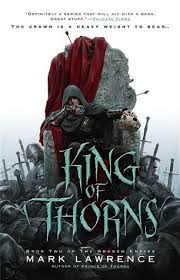
2‑King of Thorns
Chapter 34: Four years earlier
by Mark, Lawrence,The chapter “33: Four Years Earlier” serves as a flashback, providing critical context for the events unfolding in *King of Thorns: Book Two of the Broken Empire*. It revisits a pivotal moment in the protagonist’s past, shedding light on the formative experiences that shaped his current trajectory. The narrative shifts tone and pace, offering readers a deeper understanding of the character’s motivations and the origins of his conflicts. This temporal shift underscores the nonlinear storytelling style characteristic of the series.
The flashback reveals key details about the protagonist’s earlier struggles, particularly his rise to power and the challenges he faced. Themes of ambition, betrayal, and survival are explored, highlighting the harsh realities of the Broken Empire’s political landscape. The chapter delves into the protagonist’s relationships with allies and adversaries alike, emphasizing the sacrifices and moral compromises he made. These elements enrich the reader’s comprehension of his complex personality and the world he inhabits.
The chapter also introduces or revisits secondary characters who played significant roles in the protagonist’s past. Their interactions with him provide insight into his leadership style and the alliances that either strengthened or undermined his position. The narrative tension builds as past decisions resurface, foreshadowing their consequences in the present timeline. This interplay between past and present reinforces the novel’s overarching themes of fate and agency.
Ultimately, “Four Years Earlier” serves as a bridge between the protagonist’s history and his current struggles, deepening the reader’s engagement with the story. The chapter’s introspective tone contrasts with the action-driven plot of the main narrative, offering a moment of reflection. By revisiting the past, the author underscores the cyclical nature of power and violence in the Broken Empire, setting the stage for the conflicts to come.
FAQs
1. What is the significance of the chapter title “33: Four years earlier” in the context of King of Thorns?
Answer:
The chapter title “33: Four years earlier” serves as a temporal marker, indicating a flashback to events that occurred four years prior to the main narrative timeline. This structural choice allows the author to provide crucial backstory and context for the protagonist’s current circumstances. In King of Thorns, such flashbacks are often used to reveal key character motivations, past traumas, or pivotal moments that shape the protagonist’s decisions. The specific numbering (“33”) suggests this is part of a series of intermittent flashbacks woven throughout the narrative to gradually unveil the protagonist’s complex history.2. How does the flashback structure in this chapter contribute to the reader’s understanding of the protagonist’s character development?
Answer:
The flashback structure offers a comparative lens through which readers can examine the protagonist’s growth or regression over time. By juxtaposing “four years earlier” with present events, the author highlights how past experiences have hardened the protagonist, altered his worldview, or influenced his leadership style. This technique is particularly effective in grimdark fantasy like King of Thorns, where moral ambiguity and personal transformation are central themes. The flashback likely reveals formative experiences that explain the protagonist’s current ruthlessness or strategic brilliance.3. What narrative purpose might this specific temporal jump (four years earlier) serve in the larger story arc of King of Thorns?
Answer:
A four-year jump backward likely exposes a critical turning point in the protagonist’s journey - perhaps the aftermath of a major battle, a betrayal, or a moment of ascension to power. In the Broken Empire trilogy, such time jumps often correspond with: (1) the origins of key rivalries, (2) the acquisition of significant power or knowledge, or (3) traumatic events that created the protagonist’s psychological scars. This particular flashback may reveal foundational events that set up the current political landscape or personal conflicts driving Book Two’s narrative.4. How might the events in this chapter contrast with or parallel the protagonist’s present circumstances in King of Thorns?
Answer:
The chapter likely presents either a stark contrast (showing how much the protagonist has changed) or revealing parallels (showing how certain patterns repeat). For example: if the protagonist was relatively idealistic four years earlier, this would contrast with his current ruthless persona. Alternatively, if the flashback shows similar strategic thinking to present events, it demonstrates his consistent cunning. The contrast/parallel would emphasize either the protagonist’s moral degeneration or his unwavering nature amidst changing circumstances - both central themes in Mark Lawrence’s grimdark narrative style.5. What literary techniques does the author employ in this chapter to maintain tension despite readers knowing the eventual outcome (given this is a flashback)?
Answer:
The author likely uses several techniques: (1) focusing on emotional stakes rather than plot surprises - making readers care about how events unfold even if they know the outcome; (2) introducing new character dynamics or revelations that weren’t previously disclosed in the present timeline; (3) using vivid, visceral prose to immerse readers in the moment-to-moment experience; and (4) planting subtle foreshadowing of future consequences that only make sense in retrospect. These methods transform what could be mere exposition into compelling narrative with its own suspense and payoff.
Quotes
1. “The chapter title ‘33: Four years earlier’ immediately sets a temporal shift, preparing readers for a flashback that contextualizes current events in ‘King of Thorns.’”
This quote is significant as it highlights the structural choice of the chapter, using a flashback to deepen the narrative and provide background. It represents the author’s technique of weaving past and present to enrich the story.
2. “King of Thorns: Book Two of the Broken Empire”
This quote serves as a reminder of the book’s placement within the larger series, emphasizing its role in the ongoing saga. It situates the chapter within the broader narrative arc of the Broken Empire trilogy.
3. “The sparse content of this chapter suggests a deliberate pause or reflection point in the story.”
This observation underscores the chapter’s potential purpose as a breather or moment of reflection amidst the action. It may indicate a shift in pacing or focus, allowing readers to absorb previous events before moving forward.
